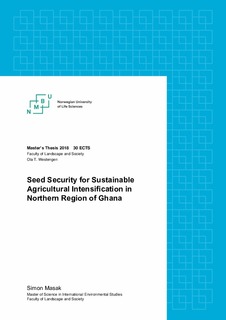| dc.contributor.advisor | Westengen, Ola T. | |
| dc.contributor.advisor | Oboubi, Kenneth | |
| dc.contributor.author | Masak, Simon | |
| dc.coverage.spatial | Ghana | nb_NO |
| dc.date.accessioned | 2018-10-09T10:33:08Z | |
| dc.date.available | 2018-10-09T10:33:08Z | |
| dc.date.issued | 2018 | |
| dc.identifier.uri | http://hdl.handle.net/11250/2567060 | |
| dc.description.abstract | For smallholder farmers (SHFs) in the savanna ecological zone of Ghana seeds are crucial for livelihood security. Access to quality seeds is a fundamental contribution to the yields farmers attain from their crop production. In the face of climate change, SHFs depend on various measures to adapt their production to ensure continued sustained crop production. The use of cultivar adjustment is deemed by the Intergovernmental Panel on Climate Change (IPCC) as one of the most effective ways to adapt to changing climate. The conventional agricultural development pathway to cultivar adjustment is that new crop cultivars are developed by crop scientist for release to farmers. In the savanna ecological zone of Ghana, the Savanna Agriculture Research Institute (SARI) is mandated to develop new crop varieties to farmers.
It is however noted that, adoption of improved crop varieties by SHFs is still generally low. Above eighty percent (80%) of seeds used by farmers in sub-Saharan Africa is derived from the informal seed sector. The crops’ characteristics, the financial ability of farmers, the policy or institutional mechanisms of the seed sector, the seed sector regimes and the sociocultural and economic factors largely influence adoption of improved crop varieties.
There is concern as to whether new crop varieties developed by researchers through their breeding activities meets the needs of farmers in the area. This therefore formed the basis of this research to determine if breeder perceptions of crop characteristic differ from the characteristics of farmers. This thesis therefore contributes to the understanding of adoption and its determinants in Northern Ghana. I particularly focus on whether or not the varieties developed are suitable for smallholders in the area. I assess and compare smallholder farmers’ crop varietal use, needs and preferences in relation to the breeding objectives of plant breeders. | nb_NO |
| dc.language.iso | eng | nb_NO |
| dc.publisher | Norwegian University of Life Sciences, Ås | nb_NO |
| dc.rights | Attribution-NonCommercial-NoDerivatives 4.0 Internasjonal | * |
| dc.rights.uri | http://creativecommons.org/licenses/by-nc-nd/4.0/deed.no | * |
| dc.title | Seed security for sustainable agricultural intensification in the northern region of Ghana | nb_NO |
| dc.type | Master thesis | nb_NO |
| dc.description.version | submittedVersion | nb_NO |
| dc.description.localcode | M-IES | nb_NO |

